The Data Whisperer You Need to Meet
Have you ever felt like you're trying to run through treacle with your current data systems? Enter BigQuery, Google's powerhouse data warehouse that makes handling massive datasets feel like a breeze. It's not just another tool; it's the Formula 1 engine in the world of data analysis, designed to put you miles ahead of the competition. BigQuery is part of the Google Cloud suite, known for its serverless, scalable, and cost-effective features that allow for super-fast SQL queries on large scales. Think of it as an upgrade from a dripping tap to a fire hose - quick and powerful. It…







